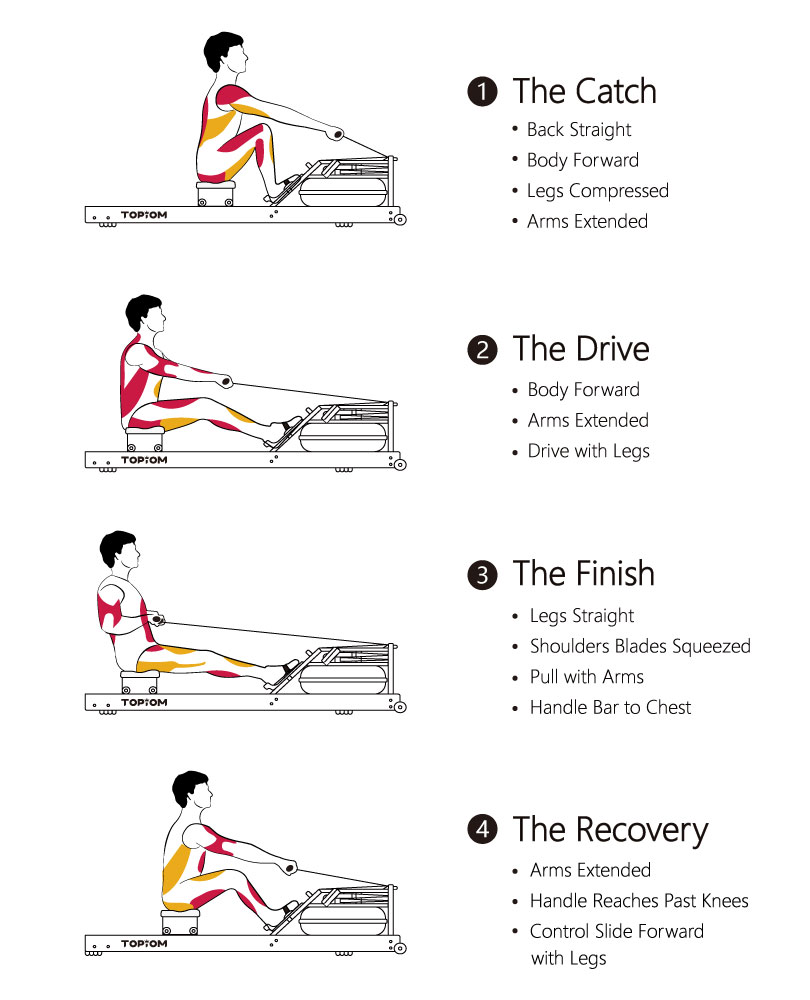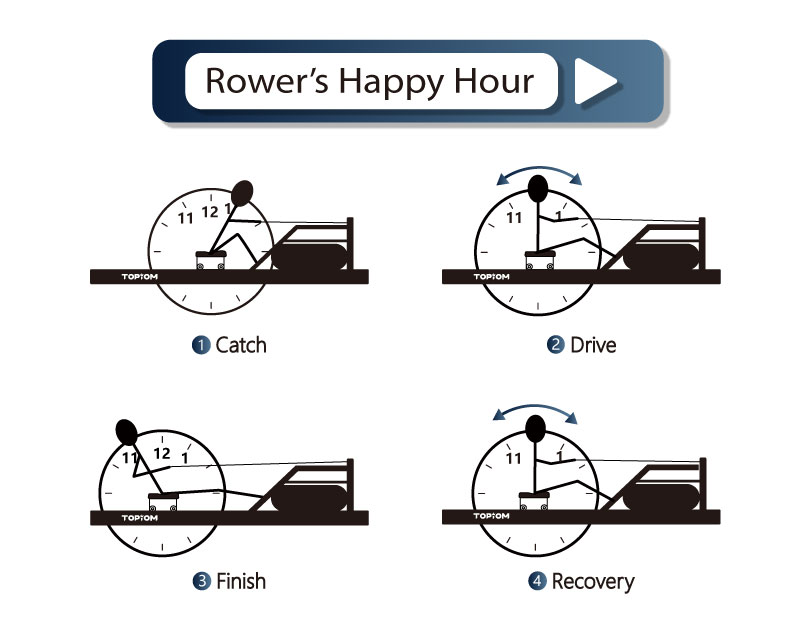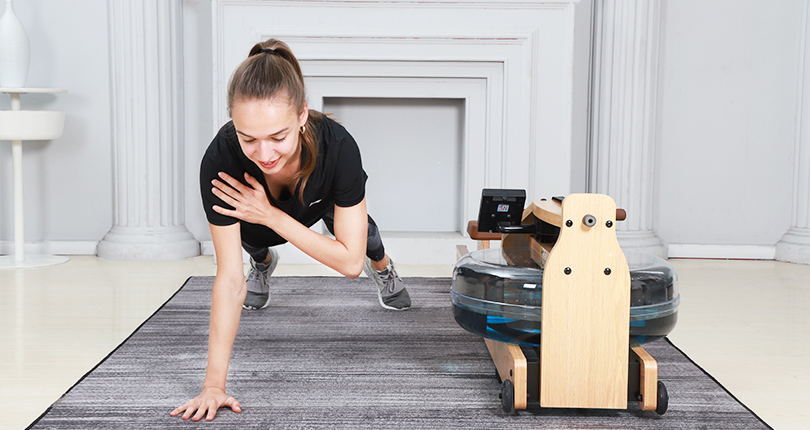Whatever your fitness goals may be, there are specific rowing machine workouts that will help you row closer to your goals. An indoor rowing machine offers a great way to train and reap the amazing benefits of this full-body workout machine with zero or low impact.
Unfortunately, many novice rowers fail to get the most out of their exercises because they have none or little ideas about rowing machine workouts.
If this is the case for you, then you’re in the right place. Read on to learn about the major types of this exercise as well as some trendy rowing workouts that will take your exercise routine to a whole new level!
Table of Contents
- Major Types of Rowing Machine Workouts
- Trendy Rowing Machine Workouts You Need to Try in 2021
- Tips for Beginners to Perform Rowing Machine Workouts
- Training Resources for Rowing Machine Workouts
- Health Reminder
- The Bottom Line
Major Types of Rowing Machine Workouts
Learning to row on the rowing machine can be tough, especially when you’re trying to figure out how to make up workouts. In this case, understanding the major types of rowing machine workouts will help you reach your fitness goals more quickly and efficiently.
1. Steady-State Rowing Machine Workouts
Steady-state rowing workouts emphasize continuous rowing at a consistent intensity and stroke rate for a set time or distance.
Stroke rates are usually around 20-24 strokes per minute (SPM). Speed is dependent on technique, such as your stroke length and power application. Meanwhile, you need to keep your intensities within 60-70% of your maximum heart rate (MHR). The workout duration depends on your fitness level and can be based on time or distance.
Steady-state rowing is aerobic. It requires oxygen and is fueled mostly by stored fat. Thus it is particularly good for endurance training and fat burning. Low-intensity steady-state rowing is a popular workout.
2. Interval Rowing Machine Workouts
Interval rowing workouts are composed of shorter periods of work at higher intensities followed by periods of rest (or very easy effort). While interval training often refers to HIIT (high-intensity interval training) workouts, you can implement intervals on the rowing machine more creatively
Both work and rest periods can be varied based on different rowing metrics like time, distance, stroke count, and SPM. Intensities of work periods can vary between 75% and 95% of your maximum heart rate. While intensities of rest periods can vary between 40% to 50% of your MHR. You can design long intervals, short intervals (eg. high-intensity intervals), short rest intervals (eg. Tabata intervals), and variable-length intervals (eg. pyramid intervals).
· Long Intervals
Long intervalsare rowing workouts with each work period taking 4 minutes in length, strokes, and longer.
>4 x 4 minutes, with 2-4 minutes rest
>2 x 2000 meters, with 4-6 minutes rest
>4 x 150 strokes, with 3 minutes rest
· Short Intervals
Short intervals are rowing workouts with each work period taking less than 4 minutes in length and strokes.
>1 minute hard/1 minute easy
>6 x 500 meters, with 2 minutes rest
>5 x 50 strokes, with 2-3 minutes rest
· Short Rest Intervals
Short rest intervals are designed with very short rest intervals in the range of 10-30 seconds. This allows your body to clear some of the lactate, but your heart rate stays pretty high.
>8 x (20 seconds hard/10 seconds easy)
>1 minute hard/30 seconds easy
>20 strokes hard, 5 strokes easy
· Variable Length Intervals
Variable-length intervals are open to creative possibilities. Pyramids, step-ups, step-downs are the three major types of variable length intervals.
>1-2-3-4-3-2-1 minutes hard, with rest equal to the work time
>500 meters, 1000 meters, 1500 meters, 1000 meters, 500 meters, with 2-4 minutes rest in between work intervals
>5 minutes, 4 minutes, 3 minutes, 2 minutes, 1 minute hard, with 2 minutes rest in between
Trendy Rowing Machine Workouts You Need to Try in 2021
1. HIIT
High-Intensity Interval Training (HIIT), is the buzzword of the fitness world. HIIT rowing workouts contain short bursts of intense rowing periods (> 80% of MHR), followed by timed periods of recovery (lower effort rest intervals). The idea is to push your body to its limit for a short period of time, followed by a period of recovery before another intense effort. This pattern is repeated several times.
HIIT comes with many benefits, including time efficiency and great fat-burning capability. Wanna know more about the chemistry between HIIT and rowing machine workouts? Read our post: HIIT Your Rowing Machine: Feel the Burn and find out more!
Doing HIIT workouts a few times per week is a great way to get stronger and faster, have more endurance in your runs, burn more calories (even while you sleep), increase your metabolism, and improve your overall physical performance. It’s also great for helping boost metabolism, preserve the body’s lean muscle mass, and gaining cardiovascular and fat-burning benefits.
2. Tabata
This type of workout is named after the legendary fitness coach Izumi Tabata. It is a type of HIIT workout that aims to yield the most benefits in just four minutes. Although short in duration, it is considered one of the most strenuous and challenging HIIT workouts that will develop the kind of power you need to blow past any of your personal records that you held previously.
For each rowing session, you do eight rounds of 20 seconds of strenuous rowing followed by 10 seconds of rest.
3. Pyramid
Pyramid rowing involves a gradual increase in work done followed by a gradual reduction in work done. The workout durations can be based on time, stroke count, or distance.
4. LISS
LISS, or Low-Intensity Steady State Training, involves consistent effort at a steady pace (40-60% of your MHR) for an allotted amount of time. Your heart rate is usually monitored to identify your effort during the workout.
You should still be able to hold a conversation whilst performing LISS rowing. It’s a good form of exercise to do with your friend or family.
LISS is accessible and scalable to all fitness levels. It is great for increased energy, better blood flow, a stronger heart, and overall cardiovascular health. Plus, in the initial stages of a workout program, it offers effective fat burning.
Tips for Beginners to Perform Rowing Machine Workouts
1. What is the correct rowing technique for beginners?
Check the indoor rowing technique for beginners to learn the basics and develop proper technique. It offers you instructional techniques on how to perform a correct stroke on a rowing machine. Additionally, tips on how to create power as well as how to breathe during your rowing machine workouts are also provided.

2. What are the don’ts on a rowing machine?
There are some common mistakes you should avoid when first hit the rowing machine. As they will not only make you miss out on the primary/ indoor rowing has to offer, but also might cause muscle strains and further injuries. These mistakes include, but are not limited to:
- Rowing with your arms only rather than pushing with your legs
- Hunching your back rather than sitting up straight
- Bending your knees before straightening your arms on the recovery
- Death gripping the handle rather than having a nice loose grip
- Holding your breath rather than having rhythmic breathing during the workout
- Leaning back extremely rather than finishing at the 11 o’clock position

3. How to measure the performance of your rowing machine workouts?
Split, SPM, Watt… if you’re unfamiliar with these terms, you’re not alone. As a beginner, you might be very confused about the numerous terms of rowing, not to mention measure your performance and set useful targets for your workouts. If that’s the case, familiarize yourself with some of the most common rowing machine terminologies will help you better understand the rowing machine as well as rowing workout metrics.
Normally on the performance monitor of the machine or relevant compatible apps, two important rowing metrics will be provided so that you could keep track of your performance while you row.
1 Speed, measured in strokes per minute (or SPM).
2 Split time, which is a ratio of how many meters you can row in a period of time, and represents your stroke intensity.
4. How long should a beginner row on a rowing machine?
If you’re a beginner, start with a row of 3–5 minutes. Then take a break to stretch and walk around. If you feel good, do up to four of these short intervals of rowing. You can either do it alone or add it on at the end of your regular cardio workout.
You may gradually add time each week as you get used to the movement. But be conscious of how ready your body and mind are for the exercise first. Then listen to your body to avoid overtraining injuries.
5. Always perform a suitable warm-up and cool-down
You should perform a suitable warm-up and cool-down before and after every rowing machine workout session. This will not only boost your performance, but prevent you from injuries, and help you better recover from your workout.

Besides, you should always stretch after a workout. Target the hamstrings, glutes, abdominals, and lats in particular. Because spending time stretching after your rowing workout could help relieve muscle soreness promote muscle growth. A study published in the Journal of Applied Physiology found that intense stretching after working a muscle group can increase its mass by 318% in 28 days.
Training Resources for Rowing Machine Workouts
Here are some free online training resources to help you reap the benefits of rowing machine workouts faster. Whether you’re a complete novice or a rowing pro, there is something for you.
If you prefer watching videos, Dark Horse Rowing and Training Tall have numerous instructional yet interesting videos to help you get started or advanced with indoor rowing machines on their YouTube channel, providing great workout ideas and rowing content in general. British Rowing hosts an indoor rowing exercise class called “Go Row Indoor”, providing you technique and workout videos that are available anytime on YouTube, helping you to master indoor rowing and get fit in the process! Wanna make your indoor rowing more enjoyable? Indoor rowing scenery and workout brings the river home and provides you beautiful rowing routes.
If you’re a reading person, there are many blogs and websites listing various rowing workout plans and tips to improve your rowing technique.
Check out our post: best free online resources for rowing machine workouts for details.
Important Note
Always consult your physician or doctor before beginning any new exercise regimen. Since only your doctor or physician can determine whether it is right for your needs. Knowing whether you are medically able to participate and how much exercise is safe for you is essential to prevent you from damages or injuries.

The Bottom Line
Now that you know the details of rowing machines as well as tips for performing workouts, go get a rowing machine and start reaping the benefits of rowing machine workouts practice your rowing exercise.
Have fun and enjoy your journey!

